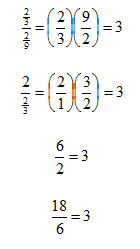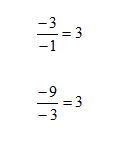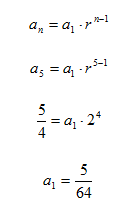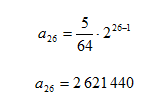Geometric
| Site: | Clare-Gladwin RESD |
| Course: | Michigan Algebra II KHauck |
| Book: | Geometric |
| Printed by: | Guest user |
| Date: | Wednesday, December 17, 2025, 9:54 PM |
Description
Geometric
A geometric sequence is a sequence that has a common multiplier between terms. This ratio is constant and is called the common ratio, r. The difference between consecutive terms in a geometric sequence varies, unlike an arithmetic sequence.
An example of a geometric sequence is 1, 2, 4, 8, 16 … and the common ratio of this sequence is 2. To change from one term to the next in the sequence, multiply by two.
Example 1
Find the common ratio of the following sequence:

To find the common ratio, divide any consecutive pair of terms.

The ratio is always 3, or r = 3
Example 2
Write the first four terms of a sequence given that an = 3 · 2n-1 .
Step 1. Find the first term. To find the first term, a1, substitute the term number, n = 1 in the formula and solve.
a1 = 3·21-1
a1 = 3
Step 2. Find the second term. To find the second term, a2, substitute the term number, n = 2 in the formula and solve.
a2 = 3·22-1
a2 = 6
Step 3. Find the third term.
a3 = 3·23-1
a3=12
Step 4. Find the fourth term.
a4 = 3·24-1
a4 = 24
The first four terms of the sequence are 3, 6, 12, and 24.
Explicit Models
The following steps lead to an important discovery. Remember, when finding the next term in a geometric sequence, multiply by the common ratio, r.Third Term: a 3 = a2?r
The formula above is also known as the explicit formula and is used to determine the nth term when the previous term is unknown. When simplified, this formula becomes: ![]() and is exponential.
and is exponential.
Example 1
Find the first four terms of a geometric sequence whose first term is 2 and whose common ratio is 4.
Step 1. Use the first term and the common ratio to find the terms.
2 x 4 = 8
8 x 4 = 32
32 x 4 = 128
Therefore, the first four terms are 2, 8, 32, and 128.
Example 2
Find the 15th term of a geometric sequence whose first term is 2 and whose common ratio is 4.
Step 1. Use the formula to determine the explicit model.

Step 2. Substitute the position of the term into the model and solve.
To find term 15, use n = 15.

Example 3
Find the explicit model for the following sequence:
-1, -3, -9, -27 …
Step 1. Determine the common ratio.

Every ratio will be three, r = 3.
Step 2. Substitute r = 3 and a1 = -1 into the formula and simplify.

Example 4
Find the nth and the 26th terms of the geometric sequence with a5 = 5/4 and a12 = 160.
Step 1. These two terms are 12 - 5 = 7 places apart. Based on the definition of a geometric sequence stated earlier in this unit, a12 = ( a5 )( r7 ). Use this equation to solve for the value of the common ratio, r.

Step 2. Using information from one of the given terms, substitute and solve for a1.

Step 3. Substitute a1 into the formula.

Step 4. Find the 26th term.
Substitute n = 26 into the formula and solve.

Compound Interest
Compound interest is interest paid on earned interest. The interest is paid on the principal and on the interest that has already been paid. Compound interest was discussed during the exponentials and logarithms unit. The process is based on a geometric sequence. The following example will develop a geometric sequence and an explicit formula for that sequence.Example
Sara invested $1,000 in a savings account paying 4% interest compounded annually. Determine the amount of money Sara will have in the account at the end of the first five years.A 4 = 1124.86 + (.04)(1124.86)=1124.86 + 44.99= $1169.85
A 5 = 1169.85 + (.04)(1169.85)=1169.85 + 46.79= $1216.64
Recursive Models
Another way to represent a geometric sequence is a recursive function, or any model that demonstrates how to find the next term in a sequence. In order to find the next term, an, multiply the previous term, an-1, by the common ratio. An example of a recursive model is: an = r · an-1 . This formula is also known as the recursive formula and is used when previous terms and the common ratio are known values.
Example Write a recursive function to model the following sequence:
3, 6, 12, 24, 48 …
Step 1. Determine the common ratio.

The common ratio is two, r = 2.
Step 2. Write a recursive model and reference the first term.

Video Lessons
To learn how to find common ratios, select the following link:
Identifying Geometric Sequences
To learn how to find the general formula for geometric sequences, select the following link:
Finding the nth Term in a Given Geometric Sequence
To learn how to find the nth term of geometric sequences, select the following link:
Finding the nth Term Given Two Terms
Guided Practice
To solidify your understanding of geometric sequences, visit the following link to Holt, Rinehart, and Winston Homework Help Online. It provides examples, video tutorials and interactive practice with answers available. The Practice and Problem Solving section has two parts. The first part offers practice with a complete video explanation for the type of problem with just a click of the video icon. The second part offers practice with the solution for each problem only a click of the light bulb away.
Guided PracticePractice
*Note: If Google Docs displays, "Sorry, we were unable to retrieve the document for viewing," refresh your browser.
Video Lesson:
Answer Key
Geometric Sequences Answer Key
*Note: If Google Docs displays, "Sorry, we were unable to retrieve the document for viewing," refresh your browser.
Sources
Sources used in this book:Embracing Mathematics, Assessment & Technology in High Schools; a Michigan Mathematics & Science Partnership Grant Project
Florida Virtual School, http://www.flvs.net/ (accessed 2/25/2010).
Holt, Rinehart & Winston, "Guided Practice." http://go.hrw.com/math/midma/gradecontent/loadlesson.html?course=c3&chapter=12&lesson=2&SE=1&sz_audio=1&calc=1&state=xx&actCourse=4 (accessed 7/14/2010).
Holt, Rinehart & Winston, "Sequences and Series." http://my.hrw.com/math06_07/nsmedia/homework_help/alg2/alg2_ch12_04_homeworkhelp.html (accessed 7/14/2010).
Ohio Department of Education, "Compounding the Problem - Grade 11." http://ims.ode.state.oh.us/ODE/IMS/Lessons/Web_Content/CMA_LP_S04_BC_L11_I02_01.pdf (accessed 8/10/2010).
Stapel, Elizabeth. "Arithmetic and Geometric Sequences." http://www.purplemath.com/modules/series3.htm (accessed 2/25/2010).